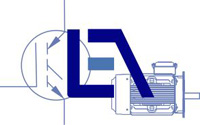Kilthau
Dr.-Ing. Andreas Kilthau
"Drehgeberlose Regelung der Synchronen Reluktanzmaschine" (2002)
The synchronous reluctance machine (SyncRel) has been subject of many investigations in the last years, especially those concerning the machine design and improvement of the utilization in speed controlled drives. Nowadays the SyncRel has become a possible alternative to other machines like the asynchronous or the permanent magnet synchronous machine with a performance in parts comparable or superior and various advantages beside. First and foremost, compared with permanent magnet synchronous machines it has lower costs and can function at very high speed because of the easier field weakening capability and the rugged rotor. If compared to asynchronous machines it has theoretically no rotor losses and a comparable torque density depending on the design of the machine.
This work deals with the control of the SyncRel in speed controlled drives with and without angular position sensor. Fundamental for the control scheme is the exact modelling of the machine, where especially the saturable inductances are of central interest. Due to iron saturation and the different magnetic characteristics in the rotor-axis d and q, the complexity of the dynamic equations of the SyncRel is increased and the control of the SyncRel faces some special problems different to other AC machines.
After development of an appropriate model of the machine with consideration of saturation and cross saturation effects much care is given to the measurement of the required machine parameters. For the inductance measurement a current decay test turned out to give good results. Then the structure and values of the accurate model are applied to a control scheme with position sensor. The special characteristics of the control of the SyncRel are pointed out. The measured parameters are used also for the computation of the regions of optimum operation especially in the field weakening range.
In the case of the SyncRel the obvious sensorless control method is to evaluate the magnetic unbalance of the rotor. A method for the computation of the transformation angle out of terminal voltages and currents is presented. The calculation method uses one measured value of the currents per control cycle, so additional measurements are not necessary. Operation at zero speed is realized by injection of a test signal. The quality of the angle estimation method over the whole operating range including field-weakening is discussed in detail and optimized.
For the experimental work a commercial available machine was used. Experimental results are given in order to confirm the presented method and to point out remaining differences between model and machine. Suggestions of further improvement are given also.
Using the presented accurate model of the machine, the transformation angle can be estimated out of the terminal voltages and currents over the whole speed and load range by means of a non-linear deterministic model with high quality. This investigation is a basic work regarding the use of the synchronous reluctance machine in speed-controlled electrical drives.
This work deals with the control of the SyncRel in speed controlled drives with and without angular position sensor. Fundamental for the control scheme is the exact modelling of the machine, where especially the saturable inductances are of central interest. Due to iron saturation and the different magnetic characteristics in the rotor-axis d and q, the complexity of the dynamic equations of the SyncRel is increased and the control of the SyncRel faces some special problems different to other AC machines.
After development of an appropriate model of the machine with consideration of saturation and cross saturation effects much care is given to the measurement of the required machine parameters. For the inductance measurement a current decay test turned out to give good results. Then the structure and values of the accurate model are applied to a control scheme with position sensor. The special characteristics of the control of the SyncRel are pointed out. The measured parameters are used also for the computation of the regions of optimum operation especially in the field weakening range.
In the case of the SyncRel the obvious sensorless control method is to evaluate the magnetic unbalance of the rotor. A method for the computation of the transformation angle out of terminal voltages and currents is presented. The calculation method uses one measured value of the currents per control cycle, so additional measurements are not necessary. Operation at zero speed is realized by injection of a test signal. The quality of the angle estimation method over the whole operating range including field-weakening is discussed in detail and optimized.
For the experimental work a commercial available machine was used. Experimental results are given in order to confirm the presented method and to point out remaining differences between model and machine. Suggestions of further improvement are given also.
Using the presented accurate model of the machine, the transformation angle can be estimated out of the terminal voltages and currents over the whole speed and load range by means of a non-linear deterministic model with high quality. This investigation is a basic work regarding the use of the synchronous reluctance machine in speed-controlled electrical drives.
